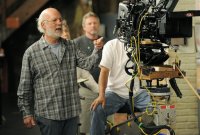Over the past few decades, characters such as Rachel Green, Sam Malone, Sheldon Cooper and Mary Richards have become household names. Millions continue to watch, quote and love the shows that made these characters famous. But what do these particular ones have in common? Aside from existing within an exclusive pantheon of iconic sitcom characters, each one was a prominent player in shows that, at one time or another, were helmed by visionary director James Burrows. Having recently directed his 1,000th television episode (for NBC sitcom “Crowded”), the television network will be honoring Burrows with a special tribute airing on Sunday, Feb. 21 at 9 p.m. EST titled “Must See TV: A Tribute to James Burrows.”
While a great deal of the buzz for this event has been focused on the “Friends” cast reuniting for the special (though, sadly, Matthew Perry will not appear in person due to rehearsals for “The End of Longing” in London), the tribute will also include the casts from other iconic shows that have benefited from Burrows’ talent, including “Taxi,” “Cheers,” “Frasier,” “The Big Bang Theory,” “Will & Grace” and “Wings.” Known for his skillful comic timing, as well as television pilots that utilized four cameras on a multi-camera set when many directors were still using three, Burrows’ most prominent work include:
“Friends’” “The Morning After” (3×16)
Burrows is responsible for one of the most emotional episodes of “Friends” (maybe in television history, depending on personal preference) in which Ross (David Schwimmer, Madagascar and the upcoming “The People v O.J. Simpson: American Crime Story”) and Rachel (Jennifer Aniston, Horrible Bosses and Office Space) tearfully break up following an unclear “break” and Ross sleeping with Chloé, the copy girl. Featuring solid performances from Aniston and Schwimmer, what takes the episode to a higher level is how cleverly it juxtaposes Ross and Rachel’s romance woes with the comedy of the other four “friends” trapped in Monica’s (Courteney Cox, “Cougar Town” and “Dirt”) room, eavesdropping, bantering and desperately trying to find something to eat aside from the “edible” waxing kit, Waxine.
Burrows also directed “Friends’” pilot episode (also known as “The One Where Monica Gets a Roommate”) and other key Ross and Rachel episodes such as “The One with the Prom Video” and “The One Where Ross and Rachel Take a Break.”
“Frasier’s” “My Coffee with Niles” (1×24)
Proving the comedy chops of its five leading characters—though Frasier (Kelsey Grammer, “The Simpsons” and Toy Story 2) and Niles (David Hyde Pierce, “Wet Hot American Summer” and A Bug’s Life) truly shine here—“My Coffee with Niles” is a stellar bottle episode (an episode of a sitcom mainly contained to one location and primarily with the main cast) that ends “Frasier’s” first season on a high note as Niles asks Frasier the ultimate question: “Are you happy?”
Burrows also directed some of the “Frasier” episodes to feature the return of Grammer’s fellow former Cheers cast members, including “The Show Where Lillith Comes Back.”
“Cheers’” “Showdown, Part 2” (1×22)
Long before Ross and Rachel disagreed over the definition of a “break,” “Cheers’” Sam Malone (Ted Danson, Becker and Fargo) and Diane Chambers (Shelley Long, “Modern Family” and The Brady Bunch Movie) originated the bickering on-again/off-again sitcom couple. Burrows won an Emmy for directing this season one finale in which Sam and Diane’s passions finally explode into a long-awaited kiss, following an argument and one of the most iconic sitcom exchanges ever: “Are you as turned on as I am?” “More!”
Burrows directed most of “Cheers’” 275 episodes.
While darker series such as “Breaking Bad” and “Game of Thrones” have undoubtedly elevated television drama to new heights, the sheer joy of watching situation comedies remains prominent. There is a reason so many college students rejoiced when “Friends” was added to Netflix last year and, in a similar vein, why people who grew up watching “Cheers” cannot resist revisiting favorite episodes. There is something special about watching a show where the characters become like a second family, where one can identify with the struggles seen onscreen (or, conversely, forget one’s real-life troubles for a while) or root for a favorite couple to end up together. In addition to talented television writers, producers and stars, it is thanks to prolific directors such as Burrows who recognize why the sitcom is such an important medium. He more than deserves this special honor.





